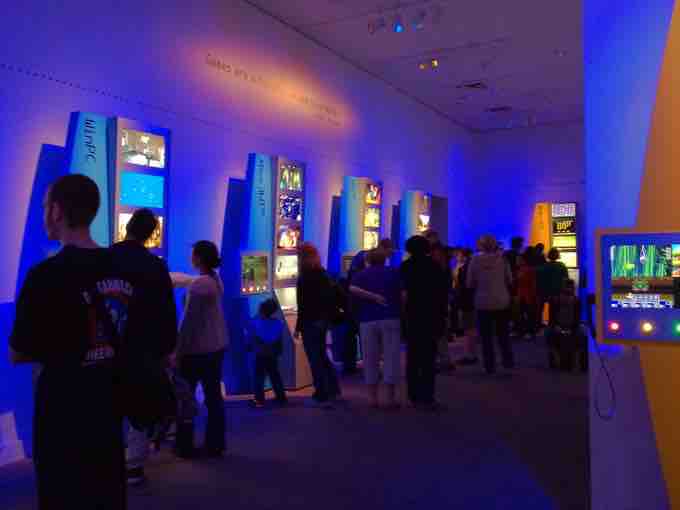Background
Video art came into existence during the late 1960s and early 1970s as new technology began to become available outside corporate broadcasting for the production of moving image work. Video art refers to the medium of video being used to create the work, which can then be broadcast, viewed in galleries, distributed as video tapes or DVD discs, presented as sculptural installations incorporating one or more television sets or video monitors.
History of Video Art
Prior to the introduction of this new technology, moving image production was only available to the consumer by way of eight or sixteen millimeter film. Many artists found video more appealing than film, particularly when the medium's greater accessibility was coupled with technologies able to edit or modify the video image. The relative affordability of video also led to its popularity as a medium.

The Art of Video Games Exhibition Crowd, March 16, 2012 - September 30, 2012
Exhibit at the Smithsonian American Art Museum that showcased video games as moving image art works.
The first multi-channel video art was Wipe Cycle by Ira Schneider and Frank Gillette. An installation of nine television screens, Wipe Cycle combined live images of gallery visitors, found footage from commercial television, and shots from pre-recorded tapes. The material was alternated from one monitor to the next in an elaborate choreography.
Prominent Video Artists
Many of the early prominent video artists were those involved with concurrent movements in conceptual art, performance and experimental film. These include Americans Vito Acconci, John Baldessari and Peter Campus among others. There were also those like Steina and Woody Vasulka who employed video synthesizers to create abstract works.
Much video art in the medium's heyday experimented formally with the limitations of the video format. For example, American artist Peter Campus' Double Vision combined the video signals from two Sony Portapaks through an electronic mixer, resulting in a distorted and radically dissonant image. Another representative piece, Joan Jonas' Vertical Roll, involved recording previously-recorded material of Jonas dancing while playing the videos back on a television, resulting in a layered and complex representation of mediation.
Joan Jonas, Vertical Roll, 1972
A still from Vertical Roll by Joan Jonas, a video that experiments with the formal limitations of video as a medium.
Video Art Today
Currently, video art is represented by two varieties - single-channel and installation. Single-channel works are much closer to the conventional idea of television in that a video is screened, projected or shown as a single image. Installation works, meanwhile, involve either an environment, distinct pieces of video presented separately, or any combination of video coupled with traditional media like sculpture. Installation video is the most common form of video art today. Sometimes it is combined with other media and is often subsumed by the greater whole of an installation. Contemporary contributions are being produced at the crossroads of such disciplines as installation, architecture, design, sculpture, and electronic art.